Education Resources
> Brennew
Buy Science Experiments for Your Classroom at Educational Innovations. K12 Professional Development. How to Help Middle and High School Students Focus on What They’re Learning, Not the Grade. Remote and blended instruction have forced an unprecedented review of teaching and learning practices.
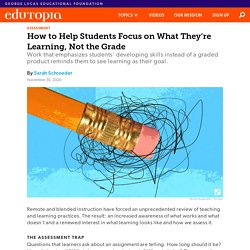
The result: an increased awareness of what works and what doesn’t and a renewed interest in what learning looks like and how we assess it. The Assessment Trap Questions that learners ask about an assignment are telling. How long should it be? How do I get an A? Historically, problematic assessment practices have taught learners that the grade is the goal by doing the following: Assessing for a score or grade Assessing for compliance (due dates, formatting, following instructions, etc.) Digging our way out of the assessment trap means shifting to learning experiences focused on skills that we want or need to measure. 3 Reasons to Focus on Process Over Product 1.
Add the stress of isolation and a global pandemic and learning challenges piled on top of challenges with motivation, memory, and ability to complete tasks. Promote a sense of belonging, support, and collaboration. 2. 3.
Differentiation – For the Teachers. Differentiation is adjusting and modifying what skills and concepts students learn, what materials they use, and/or how their learning is assessed based on the needs of the students.
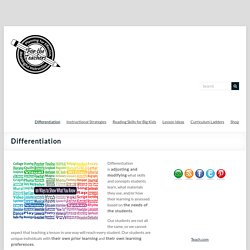
Our students are not all the same, so we cannot expect that teaching a lesson in one way will reach every student. Our students are unique individuals with their own prior learning and their own learning preferences. An effective teacher makes the changes needed to reach every student where they are and to guide them to an understanding of the skills and concepts we want them to learn. Differentiation can take place at several points during a lesson: Each of these can be further differentiated by student readiness (their academic level) and/or their personal interests and learning styles. Not every lesson needs to be differentiated, and certainly not in all of the possible ways. Printable version of Differentiation Planning diagram. Science Journal. Explain Everything Pricing, Plans, and FAQ. MURAL is a digital workspace for visual collaboration. Ken Robinson - Do schools kill creativity/ TED Talks (English subtitles)
Self-Directed Learning: A Four-Step Process. Global Connections for Teachers and Students -
We believe that connecting students with other students living in different parts of the world to share, learn and collaborate is a necessary part of any modern classroom program.
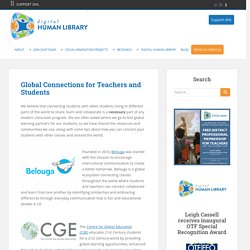
We are often asked where we go to find global learning partners for our students, so we have shared the resources and communities we use, along with some tips about how you can connect your students with other classes and around the world. Founded in 2016, Belouga was started with the mission to encourage intercultural communication to create a better tomorrow.
Belouga is a global ecosystem connecting classes throughout the world where students and teachers can connect, collaborate and learn from one another by identifying similarities and embracing differences through everyday communication that is fun and educational. (Grades K-12) ePals enriches K-12 learning in the classroom to create real world, culturally- enriching learning experiences for students. Passion.
A collection of thoughts and ideas on technology in education. STEM/STEAM: Science, Technology, Engineering, Math and the Arts. STEM/STEAM: Science, Technology, Engineering, Math and the Arts Here you'll find articles and resources for STEM+Arts education, also known as STEAM.

Topics include science, technology, engineering, math and arts education and range from research reports to feature articles to profiles of makerspaces to news about new STEAM and STEAM initiatives in schools. Ozobot Launches 1-to-1 Program Supporting Robotics at Home Robotics company Ozobot has launched a new program aimed at bringing robotics education to the home, as well as hybrid education environments. The Ozobot 1:1 Hybrid Program, as it’s called, was developed in conjunction with educators. By David Nagel09/24/20 Toolkit Delivers Anti-Racist Instruction for Middle School Math By Dian Schaffhauser09/23/20 Teaching STEM during COVID.
Kathy Schrock's Guide to Everything - Home Page. Documents. 72 Creative Ways for Students to Show What They Know. 100 Things Students Can Create To Demonstrate What They Know. 100 Things Students Can Create To Demonstrate What They Know contributed by Ryan Schaaf, Notre Dame of Maryland University When I was a high school student, I had the privilege of having a wonderful English teacher.
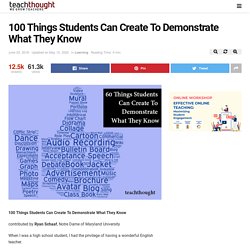
She was kind, often helped her students, and created a wonderful classroom environment that was rare in my high school experience. To this day, I regard her as a great educator; one of the very best. Due to her help, I improved my writing abilities to the point I moved ahead to an Honors course the very next year. As I now reflect upon her and my learning experiences fondly, I had only one criticism – I did the same type of work day in and day out.
Tech Buddies: Building Technology Skills Through Peer Teaching. Skills for 2022 orig. Reinventing Education for the 21st Century : Tony Wagner at (co)lab summit 2013. Building Relationships Through the Use of Technology – George Couros. This graphic above that I created with Bill Ferriter is something that I hope sparks conversations, but also stories of how these things are already happening in schools.
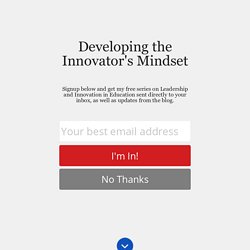
I am going to use it as a guide to show how technology can enhance, amplify, and accelerate leadership. I encourage others to share their stories from one of the “better answers” above. Building Relationships. Digital Textbooks & Education Resources. K-12 Education Tips & Strategies That Work.






